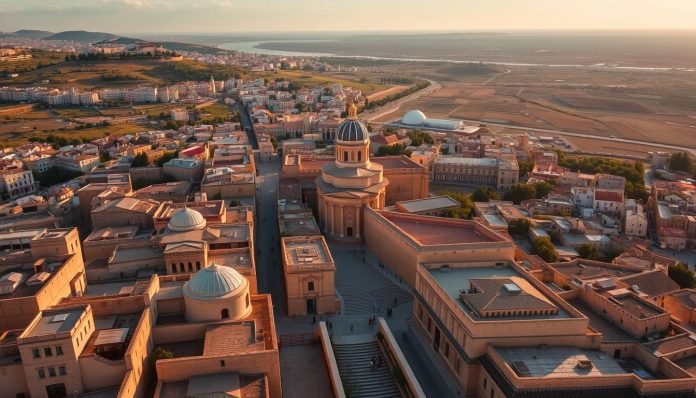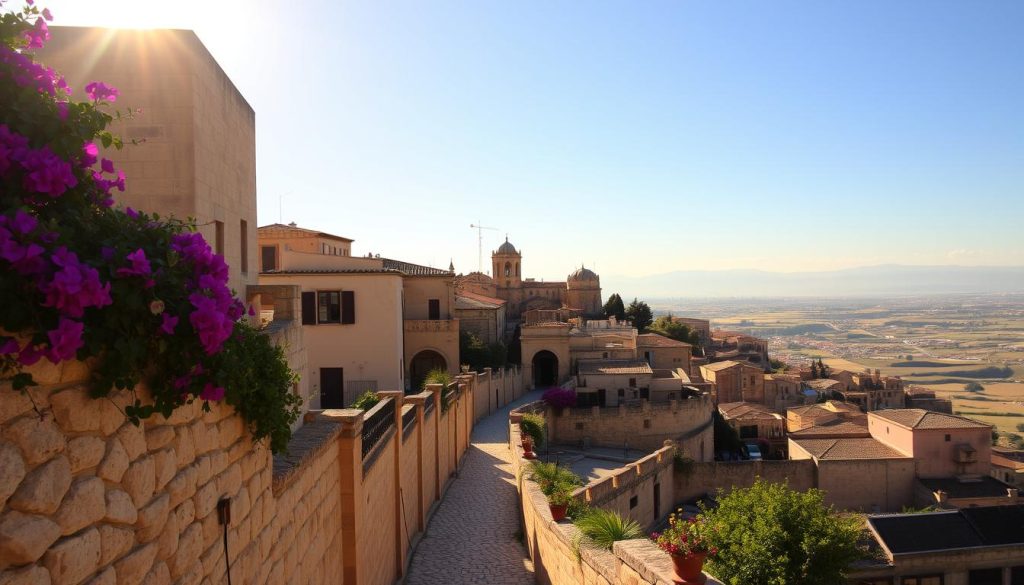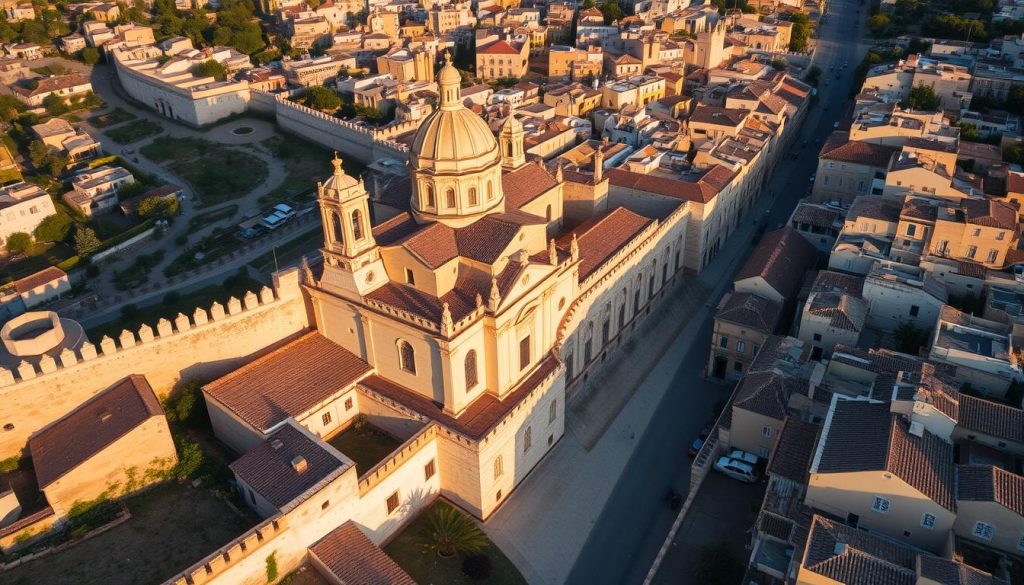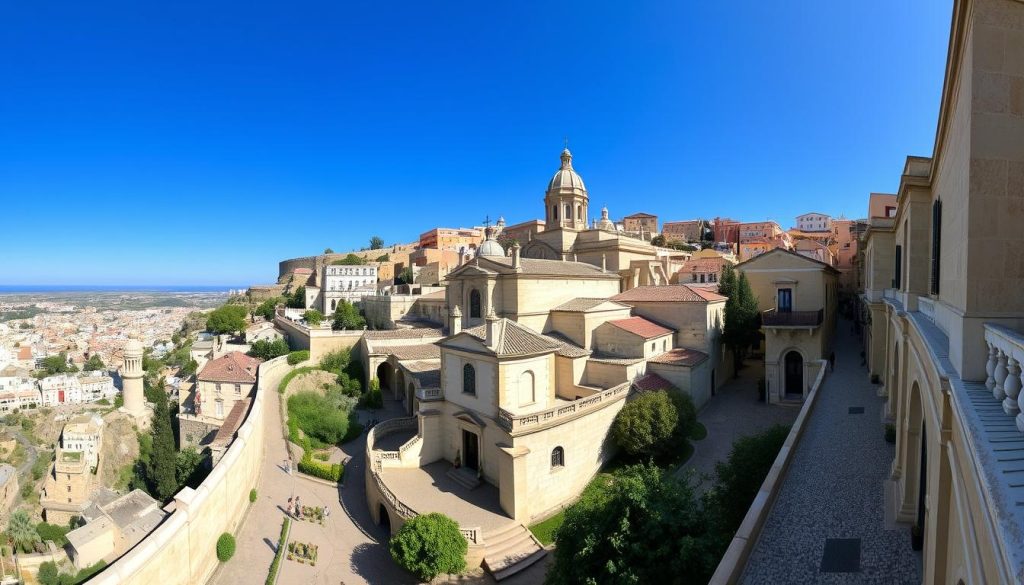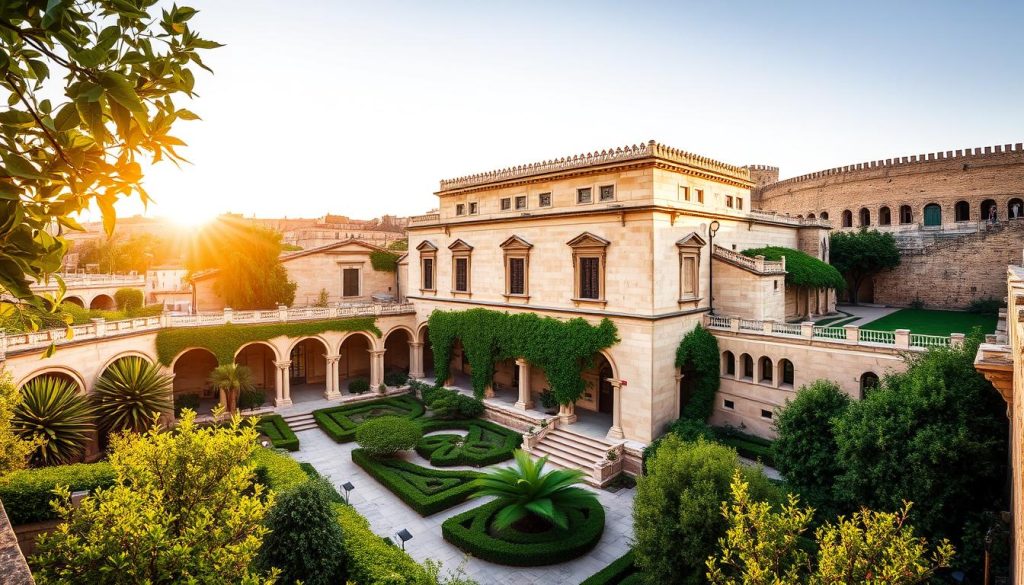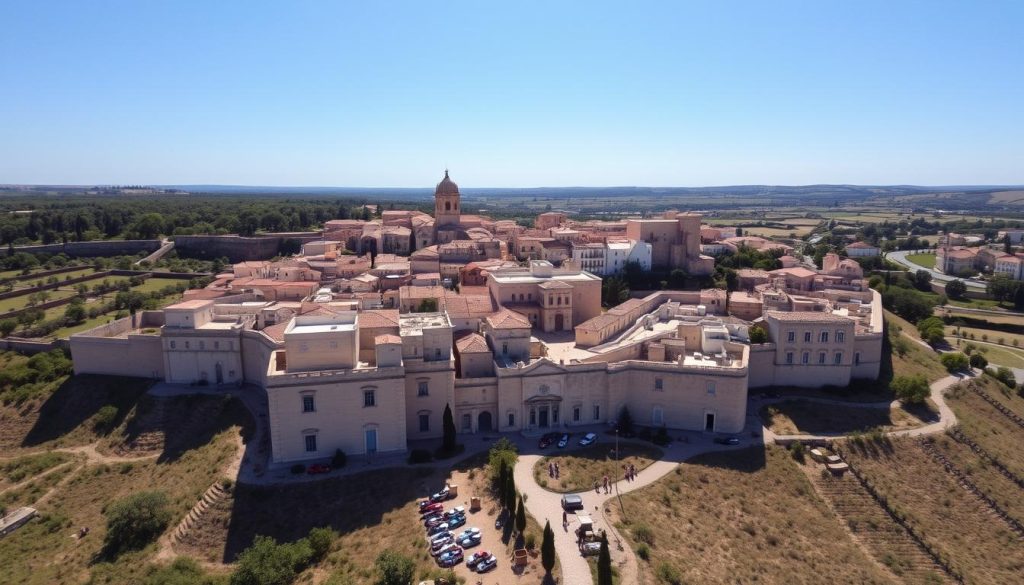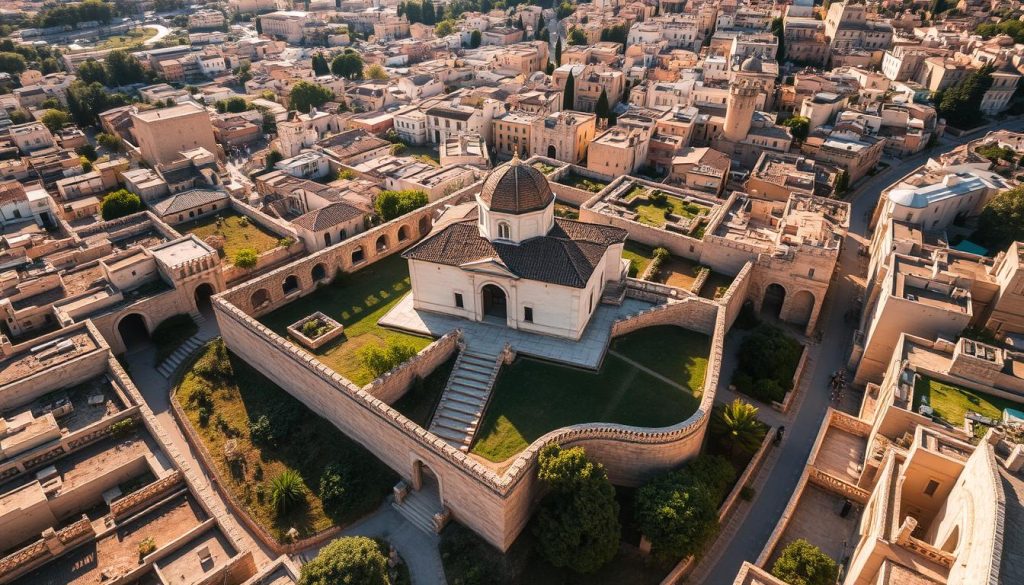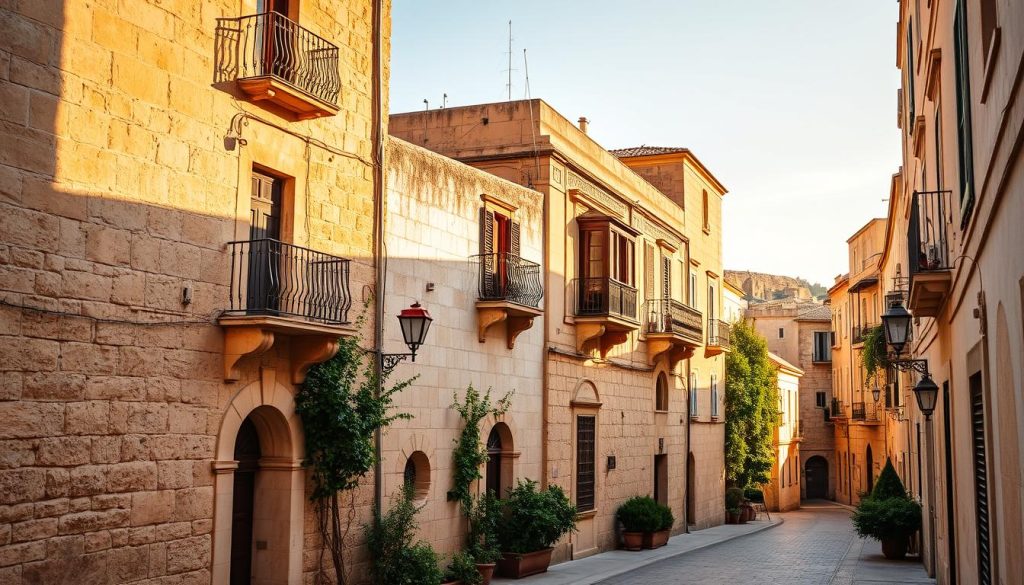Have you ever wondered what secrets lie within the walls of the ancient city known as the “Silent City”? Mdina, with its rich history, is a top Mdina historical site. It invites you to explore Malta’s remarkable past. As you wander through its narrow streets, each turn reveals stunning architecture and significant landmarks.
These landmarks tell stories of centuries of diverse cultures, from the Romans to the Knights of St. John. Whether you love history or just want to see Mdina’s best sites, this city is full of wonders. Let’s discover these historical sites that show the soul of Malta.
Introduction to Mdina: The Silent City
Mdina, known as the “Silent City,” is a treasure in Malta’s heart. It sits on a hilltop, offering breathtaking views of the island. Walking its narrow streets, you’ll see ancient buildings that tell stories of the past.
Over the years, Mdina has been more than just a capital. It was also a key military base. Its history is a mix of Roman, medieval, and Baroque styles. A tour here lets you dive deep into Mdina’s history.
Mdina’s grand walls and buildings are a call to history lovers. Step into this historic place and discover a world of stories. It’s a chance to explore Mdina’s history and enjoy its peaceful yet rich atmosphere.
Overview of Mdina Historical Sites
Mdina is a window into the past, showcasing centuries of history. You can see St. Paul’s Cathedral with its beautiful Baroque design. Palazzo Falson shows the lavish life of Malta’s nobility.
The Mdina Gate is a grand entrance to the city’s attractions. It welcomes visitors into this historic place. Each site offers a unique look into Malta’s past.
The Domvs Romana Archaeological Museum highlights Malta’s Roman history. It features detailed mosaics and ancient artifacts. These attractions tell the story of Malta’s rich heritage.
Mdina’s landmarks are preserved for future generations. Walking its ancient streets, you feel the city’s history. These sites are more than just old buildings; they are part of Mdina’s identity.
Must-Visit Historical Sites Mdina
Exploring Mdina reveals many historical sites that are a must-see. These places give us a peek into Malta’s rich history. They share stories of the people who once lived here.
St. Paul’s Cathedral is a standout. Its Baroque design attracts visitors from everywhere. The cathedral’s details tell tales of faith and skill, making it a key stop in Mdina.
Palazzo Falson is another gem. This old noble home shows off the lavish lives of Malta’s aristocrats. Walking through its halls, you feel the city’s deep history.
The Mdina Gate is the city’s main entrance. Its grand design is perfect for photos. It also sets the tone for Mdina’s historic vibe.
Many people enjoy Mdina historical tours. These tours let guides share stories and insights about these sites. They bring Mdina’s long history and culture to life.
| Historical Site | Description | Significance |
|---|---|---|
| St. Paul’s Cathedral | Baroque architectural masterpiece with intricate designs. | Represents Malta’s religious heritage. |
| Palazzo Falson | Beautifully restored noble residence. | Offers insight into noble life in Mdina. |
| Mdina Gate | Imposing entrance with medieval architecture. | Acts as a historical landmark of the city. |
St. Paul’s Cathedral: A Baroque Marvel
As you explore Mdina’s stunning sites, St. Paul’s Cathedral stands out. This architectural gem is a must-see for anyone interested in Malta’s rich heritage. Its detailed design and historical importance make it a key part of your visit.
Architecture and Design
The design of St. Paul’s Cathedral is a masterpiece of Baroque style. It boasts lavish decorations and dynamic forms. Built in the 17th century, its facade is made from local limestone.
Inside, you’ll find extravagant frescoes and remarkable sculptures. These artworks tell stories of faith and devotion. The cathedral’s design showcases incredible craftsmanship, making it a revered landmark in Mdina.
Historical Significance
St. Paul’s Cathedral is deeply rooted in Malta’s history. It’s connected to St. Paul, who was shipwrecked on the island around 60 AD. This event introduced Christianity to Malta and led to the formation of a Christian community.
The cathedral is a symbol of faith for the Maltese people. It attracts pilgrims and tourists who want to connect with its spiritual heritage. As part of Mdina’s historical sites, it offers a glimpse into the island’s transformation over time.
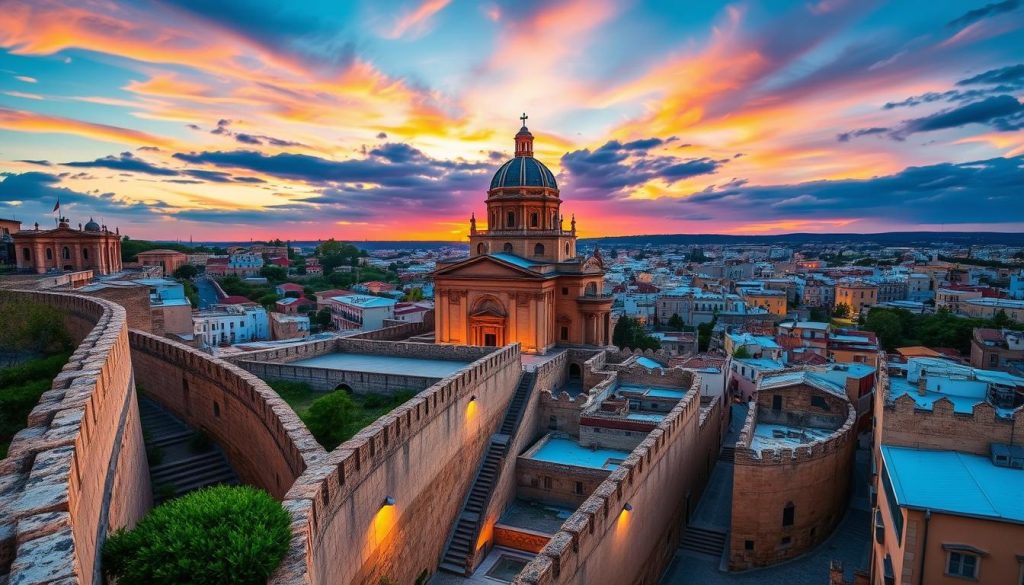
| Features | Details |
|---|---|
| Year Built | 17th Century |
| Architectural Style | Baroque |
| Main Materials | Local Limestone |
| Notable Aspects | Frescoes, Sculptures |
| Historical Association | St. Paul’s Shipwreck |
Palazzo Falson: A Historical Treasure
Visiting Palazzo Falson is a must when exploring Mdina. This 13th-century palace gives a glimpse into the lives of Maltese nobility. Walking through its halls, you’ll find the charm of Mdina’s history irresistible. Each piece tells the story of the lavish lives of those who once lived here.
Exploration of Noble Life
Palazzo Falson offers a peek into the aristocracy’s daily life. The architecture and decor show a time of grandeur, where elegance was key. You’ll see large rooms that served different purposes, giving insight into noble life in Malta.
Art and Artifacts on Display
The art and artifacts at Palazzo Falson are truly impressive. Highlights include:
- Medieval weapons that show the nobility’s martial history.
- Expensive furnishings that show how they lived.
- Beautiful tapestries that tell stories of the past.
A peaceful garden surrounds the palace, offering stunning views. This quiet space invites visitors to take a moment and think about the history in the building and its collections.
Palazzo Falson is a standout landmark in Mdina. It offers a fascinating look into the sophisticated world of Malta’s noble past.
Mdina Gate: The Entrance to History
The Mdina Gate is the main entrance to Mdina, a historic city in Malta. It was built in the 16th century by the Knights of St. John. The gate’s grand arch and strong walls show off its beauty and serve as a defense.
When you reach the Mdina Gate, you realize it’s more than just an entrance. Its grandeur and historical importance draw visitors from all over. Walking through it feels like stepping back in time, showing Mdina’s key role in Malta’s history.
Here’s a glimpse of what makes the Mdina Gate a must-see:
- Architectural splendor with detailed stonework.
- A part of the defensive fortifications of the city.
- A gateway to experiencing the enchanting atmosphere of Mdina.
- Symbol of Mdina’s historical sites and cultural heritage.
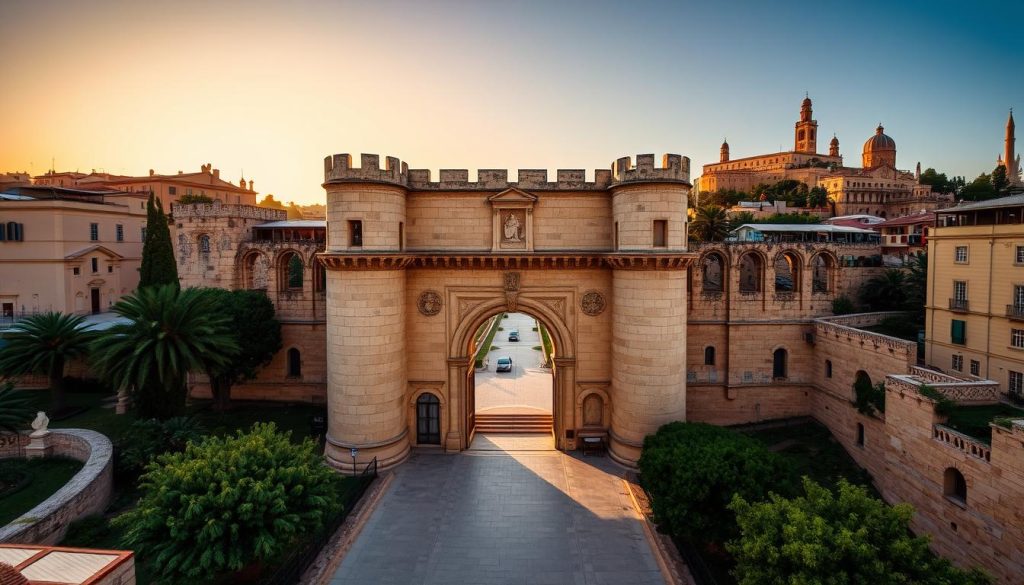
Visiting the Mdina Gate lets you see its beauty and feel its history. It’s a chance to explore Mdina’s ancient past. Step through the walls and discover the stories waiting for you.
| Feature | Description |
|---|---|
| Construction Year | 16th Century |
| Architectural Style | Military Baroque |
| Purpose | Main Entrance to Mdina |
| Visitor Experience | Gateway to Mdina’s History |
Mdina Catacombs: Exploring Early Christianity
The Mdina Catacombs are key historical sites that shed light on early Christianity in Malta. They offer a deep dive into Mdina’s history through underground burial sites. Among the top sites, St. Paul’s Catacombs and St. Cataldus Catacombs are famous for their architecture and cultural significance.
St. Paul’s Catacombs Overview
In Rabat, St. Paul’s Catacombs are a network of ancient burial chambers from the Roman era. They were later used by early Christians. Visitors can see burial niches and agape tables, giving insight into the customs and rituals of that time.
St. Cataldus Catacombs Insights
St. Cataldus Catacombs are known for their ancient Punic burial structures. Early Christians adapted these, showing how old traditions merged with new beliefs. These catacombs offer a unique look at how early communities honored the dead and formed their religious identity.
Domvs Romana Archaeological Museum
The Domvs Romana Archaeological Museum is a top historical site in Mdina. It’s set in a well-preserved Roman townhouse. Here, you get a close look at ancient Roman life through artifacts.
These artifacts include beautiful pottery, detailed mosaics, and everyday objects. They show what life was like back then.
At the museum, you can learn a lot about Roman culture and art in Malta. You’ll see how they lived and worked. It’s a must-see for anyone on Mdina historical tours.
| Artifact Type | Description | Significance |
|---|---|---|
| Pottery | Functional and decorative pieces used in daily life | Showcases artistic and practical skills of the Romans |
| Mosaics | Detailed floor designs made from colorful stones | Represents the aesthetic values and technical abilities of the era |
| Everyday Items | Tools and utensils used in Roman households | Provides insights into the daily routines and lifestyles |
In summary, the Domvs Romana Archaeological Museum is a treasure trove of history. It’s perfect for anyone wanting to learn about Roman life in Malta.
Walking Through Mdina’s Ancient Streets
Exploring Mdina’s ancient streets is a truly enriching experience. The narrow alleys weave a maze-like path, filled with history. Every turn uncovers new sights, from architectural marvels to hidden courtyards. You’ll also find local shops that bring a modern vibe to this historic place.
The streets tell tales of Mdina’s past, from ancient times to today. Walking on the cobblestones, you can almost hear the stories of those who lived here. The calm of Mdina invites you to slow down and enjoy its unique peace.
As you wander, you’ll see the beauty of Mdina’s ancient sites. The mix of medieval and Baroque styles tells a story of the city’s rich history. The views from here are stunning, showing Mdina against the Maltese landscape.
Try visiting at different times to see how the light changes the ancient stones. Dawn brings a soft glow that highlights details, while sunset paints magical shadows on the buildings.
| Feature | Description |
|---|---|
| Narrow Alleys | Winding paths that create a sense of mystery and adventure. |
| Historical Buildings | Structures that showcase a blend of Renaissance and Medieval architecture. |
| Local Shops | Unique boutiques offering artisanal products and local crafts. |
| Relaxing Atmosphere | A peaceful environment perfect for reflection and exploration. |
| Scenic Views | Breathtaking panoramas that reveal the beauty of the Maltese landscape. |
Mdina Historical Tours: Experience the Past
Mdina historical tours offer a unique way to explore the city’s rich history. Knowledgeable guides lead these tours, sharing the stories behind the architecture and culture. It’s a fascinating way to learn about Mdina’s heritage.
Each Mdina history tour includes visits to key sites. You’ll see:
- St. Paul’s Cathedral
- Mdina Gate
- The fascinating catacombs
These sites are not just impressive. They also help you understand Mdina’s history better. The guides’ stories and historical insights make the tour more than just a walk. It’s a journey through time.
Mdina Historical Sites: Preservation Efforts
Keeping Mdina’s historical sites in good shape is key to its rich heritage and beauty. Both public and private groups work hard to fix up important landmarks. They make sure the real architecture stays true while making visits better for everyone.
The Maltese people are very proud of their history. They work hard to protect Mdina’s best historical spots. Some of the main efforts include:
- Restoration projects targeting specific historical landmarks
- Implementing sustainable practices that minimize ecological footprints
- Community engagement to raise awareness and foster local pride
These efforts show a clear commitment to keeping Mdina’s special character alive for future generations. This care ensures that these sites will continue to amaze both visitors and locals.
| Preservation Efforts | Description | Impact |
|---|---|---|
| Restoration of Historical Buildings | Focused on structural integrity and original designs | Enhances visitor experience and maintains authenticity |
| Sustainability Projects | Implementation of eco-friendly practices during restorations | Protects environment while preserving history |
| Community Involvement | Encouraging locals to participate in heritage events | Strengthens community ties and cultural pride |
Conclusion
Mdina is a treasure in Malta, known for its deep history and beautiful architecture. Every corner of this city tells stories from centuries ago. It’s a place that history buffs and curious travelers love.
Places like St. Paul’s Cathedral and the Mdina catacombs offer a glimpse into the past. They give you a chance to learn about Malta’s culture and history.
Visiting Mdina’s attractions lets you connect with Malta’s lively past and its lasting impact. You can explore the grand Palazzo Falson or enjoy the quiet of the Mdina Gate. Each visit shows you more of Mdina’s special charm.
Going to Mdina makes any trip to Malta unforgettable. It’s a chance to experience a city that’s full of history and beauty. Let Mdina’s stories and stunning sights guide your next adventure.

































